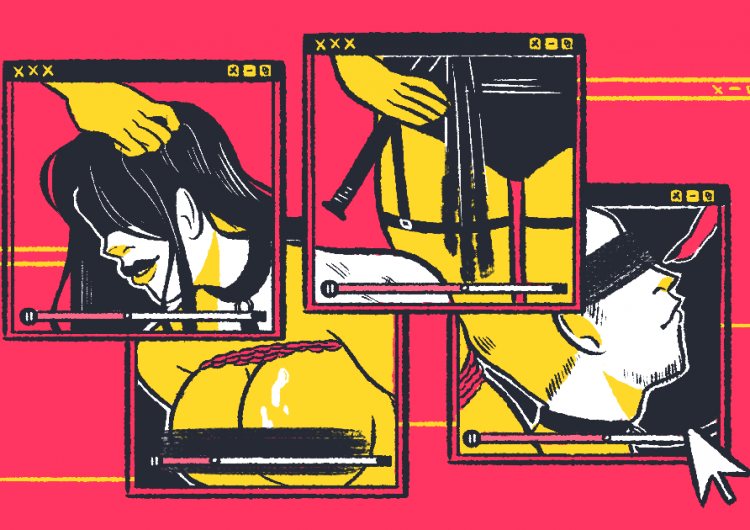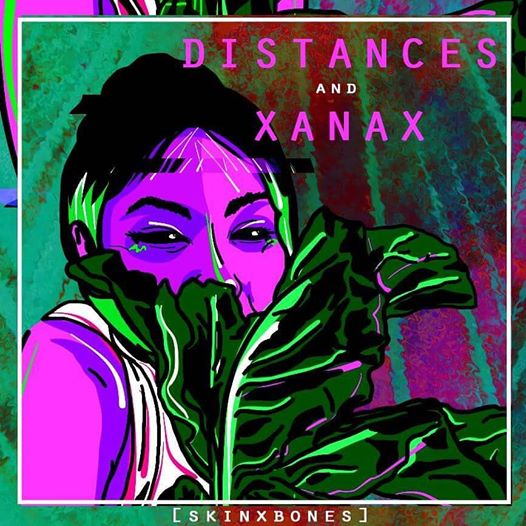Where do I get birth control and which one should I get? What does an orgasm feel like? How the hell do you do butt stuff? We answer all these questions in our new column about sex. Say hello to The Big O.
by Trisha O’Bannon
Art by Mich Cervantes
What’s the first thing you think of when you hear the word BDSM?
Leather-clad dominatrices? Underground sex dungeons? A naked girl, bound and gagged and being whipped?
Welcome to the dark side. We’ve got all of that, and some cookies.
BDSM stands for bondage & discipline, dominance & submission, and sadism & masochism. There are so many activities and practices under BDSM that this article would be over before we could list them all. Where would I even start?
Most people – even the self-described vanilla ones – enjoy a little bit of hair-pulling, spanking, or degradation every once in a while (raise your hand if you have enjoyed being called or calling someone a “slut” in bed). It gets difficult to define what exactly falls under BDSM when the line between kink and normal gets blurred all the time.
Some of the more common BDSM practices include rope bondage, choking, and heavy spanking. We won’t go into any of these in detail…yet, but we will give you a rundown of the how-to’s and what-not-to-do’s: BDSM 101.
When 50 Shades of Grey came out, I had mixed feelings. On the one hand, I was all for the normalization of BDSM culture and practices! On the other, 50 Shades is literally the worst representation of kink in the history of the world. The BDSM community welcomed many new members that year, but had to do major damage control.
Let’s tackle some of the more common questions people ask when they’re thinking about introducing BDSM into their lives:
Does liking [insert kink/fetish here] things make me weird/damaged?
NOT. AT. ALL! As long as you are having fun with yourself or other consenting adults, there’s nothing weird or wrong about wanting to get your rocks off.
Contrary to what popular media will tell you, people in the BDSM community aren’t any more or less likely to have mental health problems or traumatizing childhoods. We’re kinky not because we’re broken or have daddy issues, but because we’re kinky, and that’s just how the cookie crumbled.
Is it safe? What are the hazards?
Most if not all activities that fall under BDSM come with some risk to your emotional or physical well-being. The most important thing is not what you do, but how you do it. You can drastically reduce the risks of even the most dangerous fetishes (like whipping or rope suspensions) by reading up as much as you can on it, learning from someone more experienced, and practicing.
Paying extra attention to what happens after is also important. Aftercare is the most crucial part of any heavy kink. If you got paddled so hard that your skin is raw and stinging, your dominant will have to tend to your wounds. If you told your partner that she’s a dirty slut that no one cares about and is worth nothing, make sure to tell her how much you value her once the scene is over.
To be honest, the biggest hazard in BDSM is broken trust. Physical injuries can and will heal, but emotional trauma can last a life time. Make sure to have affirmative consent before proceeding with any act, honor each other’s safe words, and don’t use BDSM as an excuse to be a creepy dick.
What are the important things to know?
Consent is king anywhere, but even moreso in BDSM. The one thing 50 Shades got right is the contract – prior to a session with someone new, you do have to discuss your kinks and your limits. The contract can be written or even just a verbal agreement. You can always renegotiate your contract later, but breaking the terms – and your partner’s trust – can get you blacklisted from the tight-knit BDSM community.
A lot of people outside the kink community think that once you self-identify as kinky, you have to be up for anything. This isn’t quite true – we still have our likes, dislikes, and hard limits, just like anybody else. Your experience should be what you want it to be, not what other people think it should be. If you only like spanking and choking, don’t feel any pressure to engage in bondage, urine play, or anything else that makes you uncomfortable. You do you.
That being said, it’s also okay to change your mind. Sometimes a hard limit will eventually become a soft limit, or the other way around. BDSM is a constant negotiation: between you and other people, and within yourself. Learn to communicate with your partner so you can either try new things or take things off the table as necessary.
Another huge misconception in the vanilla world is that BDSM is always about sex. Sure, many of us incorporate BDSM into our sex lives, but it’s more than that; it’s an identity, a lifestyle, a community. You can practice BDSM without involving sex in any way, just because it feels good.
However you choose to practice BDSM, just be sure to do your research first. Knowing the risks is the first step in avoiding any long-term damage. Many kinksters have studied and practiced BDSM for years, refining their technique and updating their safety measures as they learn more and get better. Coming into a session prepared makes for safer and more seamless play, and it’s sexy as hell when someone knows what they’re doing.
How do people get involved the community?
There’s a thriving kink scene in Manila, and it’s happening right under your noses.
The best way to get involved is to reach out online. There’s Shibari.PH, which hosts a number of sort-of-SFW rope bondage workshops for curious individuals and couples. If you’re in the BGC area, you should attend Domina Chase’s monthly munch and kinky bar crawl.
And of course, there’s FetLife, a social media platform that connects kinksters from all over the globe. Warning: it’s definitely extremely NSFW, and can be a little overwhelming for a newbie. Tread with caution!
But the biggest congregation of kinksters is actually happening this weekend – Kink Karnival 2017 boasts a killer line-up including queen of the underworld Joyen Santos, the country’s premier burlesque troupe Burlesque PH, and comedy-erotica group Deus Sex Machina. Besides the live performances, there will also be film screenings and workshops – perfect for the budding kinkster to learn the ropes (pun intended).
Diving head first into a day of debauchery with the best and kinkiest of Manila might sound a little scary. Fear not! This dictionary will equip you with the basic knowledge you’ll need to start exploring the world of kink.
The ABC’s of BDSM
Aftercare – The period immediately after a session where both participants calm down and come back to their normal state. The dominant will often have to attend to the submissive’s physical and emotional needs; the actual aftercare routine varies depending on the submissive. It can involve the dominant soothing the submissive’s wounds (for physical play) and reassuring them of their worth (for play involving degradation). Arguably the most important part of a play session.
Blood play – Any scene or session that involves the drawing of blood.
Bondage – The act of restraining a person or body part, usually with rope or other materials.
Breath play – The act of controlling and/or limiting breathing during play. Usually involves choking.
Bunny – A kink model or bottom for performances or other live demonstrations.
Collared – A symbol and/or state of being “Owned” by a dominant. This means that a submissive exclusively plays with their Master/Owner.
Consent – Giving permission for someone else to do something , or agreeing to a set of terms. For something to be truly consensual, the consent given needs to be active (i.e. explicit), enthusiastic, and informed.
Dominant/submissive – The dominant exercises power and control over the submissive in a scene.
Drop – The emotional and physical “crash” that follows the endorphin high of a session. This can happen to both dominants and submissives.
Edge play – Play that is generally considered dangerous or high-risk. Includes but is not limited to knife play, fire play, electric play, and breath play. These are not recommended for inexperienced kinksters, since these require study and practice.
Electric play – Any scene or session that involves the use of electricity on a person.
Emotional play – Play that involves emotions, like humiliation and degradation.
Fetish – When sexual arousal is derived from a specific and non-sexual object or act.
FetLife – Like Facebook, but for kinky people.
Impact play – Play that involves being spanked, hit, or struck with an object, including hands, canes, paddles, floggers, whips, crops, etc.
Kinky – A person whose sexual desires aren’t within the norm.
Knife play – A play session that involves the use of knives. Can lead to blood play, but isn’t necessary.
Limits – What a person is willing to do and not willing to do within the context of a scene. Hard limits are non-negotiable, while soft limits are acts that the person may be willing to try.
Masochist – Someone who enjoys receiving pain, whether emotional or physical.
Master/slave – A more intense form of the dominant/submissive relationship. The master owns the slave, sometimes with the power dynamic extending beyond sessions and into everyday life.
Munch – A meetup of kinksters in a safe, neutral, and public space, such as a coffee shop or restaurant. They can be used to arrange intimate play sessions at a later date and network with the local kink community.
Pet play – The bottom or submissive is treated like a pet. Similar to a slave in that the submissive is owned, but also treasured and loved.
Play session – Also known as scene, play, or session. A specific period of time when people participate in BDSM-related activities.
RACK – One of the two most important acronyms among BDSM practitioners; stands for Risk-Aware Consensual Kink. It acknowledges that all kinks have a degree of danger or risk, but the people participating are aware of them and give their informed consent.
Sadist – Someone who derives pleasure from inflicting pain, whether emotional of physical.
Safe word – A word or gesture, established and made known to all parties involved prior to the play session, that signals the need for the play to stop or slow down.
Shibari/kinbaku – Japanese rope bondage. There is much debate about whether the two terms are interchangeable or not. Some say that shibari is the aesthetic or performative art of tying, while kinbaku is the erotic or sexual practice; for most people, it really depends on which term you prefer.
SSC – Safe, Sane, and Consensual: the three elements that need to be present for a healthy and enjoyable play session. What is “safe” and “sane” for one person may not be safe or sane for another, so this largely depends on who is involved.
Subspace – The mindset or zone that a submissive enters during an intense play session. Can be described as a floating or detached feeling, but can also vary from submissive to submissive.
Switch – A person who enjoys both dominant and submissive roles.
Top/bottom – More general terms for the active (top) and passive (bottom) persons in a scene.
Vanilla – A person whose sexual interests do not include BDSM and other kinky activities. Can also be used to describe non-kinky activities in general (e.g. vanilla sex).
Wax play – A scene that involves candle wax drippings.

























Comments